

Compact Muon Solenoid
LHC, CERN
| CMS-PAS-HIG-20-006 | ||
| Analysis of the CP structure of the Yukawa coupling between the Higgs boson and τ leptons in proton-proton collisions at √s= 13 TeV | ||
| CMS Collaboration | ||
| July 2020 | ||
| Abstract: The first measurement of the CP structure of the Yukawa coupling between the Higgs boson and τ leptons is presented. The measurement is based on data collected in proton-proton collisions at √s= 13 TeV by the CMS experiment at the CERN LHC in 2016, 2017 and 2018, corresponding to an integrated luminosity of 137 fb−1. Events are selected where one τ decays to a muon and the other hadronically, and where both τ leptons decay hadronically. These are the most sensitive decay modes for this analysis and together cover about 50% of all Higgs-to-tau decays. The analysis uses the angular correlation between the decay planes of τ leptons produced in Higgs boson decays. Machine learning techniques are deployed to distinguish between signal and background events, and dedicated analysis techniques are used to optimise the reconstruction of the τ decay planes. The mixing angle between CP-even and CP-odd τ Yukawa couplings was found to be 4 ± 17∘, compared to an expected uncertainty of ± 23∘ at the 68% confidence level, while at the 95% confidence level the observed (expected) uncertainties were ± 36 (± 55)∘. The observed (expected) significance of the separation between the CP-even and CP-odd hypotheses is 3.2 (2.3) standard deviations. The results are compatible with predictions for the standard model Higgs boson. | ||
|
Links:
CDS record (PDF) ;
inSPIRE record ;
CADI line (restricted) ;
These preliminary results are superseded in this paper, Submitted to JHEP. The superseded preliminary plots can be found here. |
||
| Figures & Tables | Summary | Additional Figures & Tables | References | CMS Publications |
|---|
| Figures | |

png pdf |
Figure 1:
The normalised distribution of ϕCP between the τ decay planes in the boson rest frame, for both τ leptons decaying to a charged pion and a neutrino. The distributions are for a decaying scalar (CP even, blue), pseudoscalar (CP odd, green), a maximal mixing angle of 45∘ (CP mix, red), and a Z vector boson (black). A pT cutoff of 33 GeV is applied on the visible τ decay products. |

png pdf |
Figure 2:
Left: illustration of the decay plane for the decay τ−→π−+ν. Middle: illustration of the decay plane as reconstructed from the neutral and charged pion momentum. Right: illustration of ϕCP for the mixed scenario, in which one τ lepton decays to a single charged pion while the other decays via an intermediate ρ meson. The illustrations are in the zero-momentum frame of the charged particles. |

png pdf |
Figure 3:
The postfit genuine τ (left), and jet-fake (right) NN scores for the τμτh channel. The distributions are inclusive in decay mode. The best-fit signal distributions are overlaid. In the bottom plot the data minus the background template divided by the uncertainty in the background template is displayed, as well as the signal samples divided by the uncertainty in the background template. The uncertainty band consists of the sum of the postfit uncertainties in the background templates. |
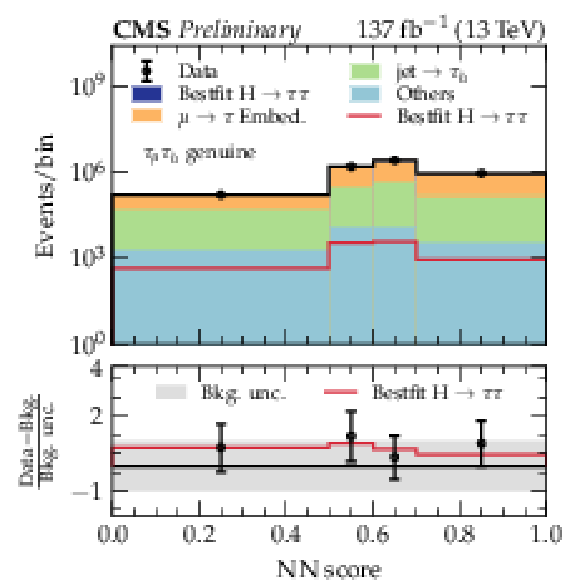
png pdf |
Figure 3-a:
The postfit genuine τ (left), and jet-fake (right) NN scores for the τμτh channel. The distributions are inclusive in decay mode. The best-fit signal distributions are overlaid. In the bottom plot the data minus the background template divided by the uncertainty in the background template is displayed, as well as the signal samples divided by the uncertainty in the background template. The uncertainty band consists of the sum of the postfit uncertainties in the background templates. |

png pdf |
Figure 3-b:
The postfit genuine τ (left), and jet-fake (right) NN scores for the τμτh channel. The distributions are inclusive in decay mode. The best-fit signal distributions are overlaid. In the bottom plot the data minus the background template divided by the uncertainty in the background template is displayed, as well as the signal samples divided by the uncertainty in the background template. The uncertainty band consists of the sum of the postfit uncertainties in the background templates. |

png pdf |
Figure 4:
The postfit genuine τ (left), and jet-fake (right) BDT scores for the τhτh channel. The distributions are inclusive in decay mode. The best-fit signal distributions are overlaid. In the bottom plot the data minus the background template divided by the uncertainty in the background template is displayed, as well as the signal samples divided by the uncertainty in the background template. The uncertainty band consists of the sum of the postfit uncertainties in the background templates. |

png pdf |
Figure 4-a:
The postfit genuine τ (left), and jet-fake (right) BDT scores for the τhτh channel. The distributions are inclusive in decay mode. The best-fit signal distributions are overlaid. In the bottom plot the data minus the background template divided by the uncertainty in the background template is displayed, as well as the signal samples divided by the uncertainty in the background template. The uncertainty band consists of the sum of the postfit uncertainties in the background templates. |
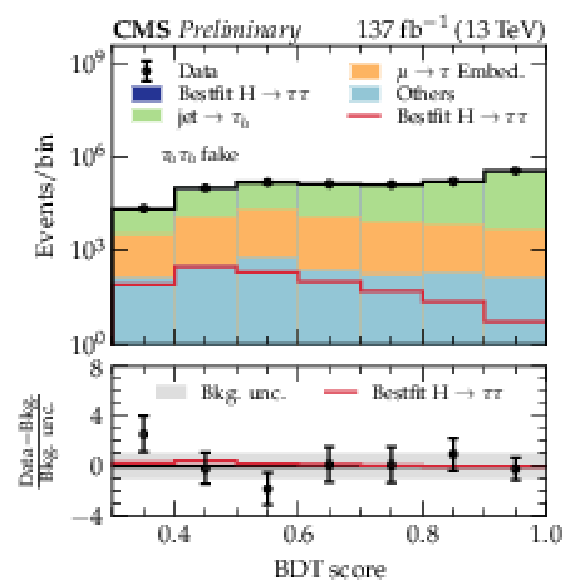
png pdf |
Figure 4-b:
The postfit genuine τ (left), and jet-fake (right) BDT scores for the τhτh channel. The distributions are inclusive in decay mode. The best-fit signal distributions are overlaid. In the bottom plot the data minus the background template divided by the uncertainty in the background template is displayed, as well as the signal samples divided by the uncertainty in the background template. The uncertainty band consists of the sum of the postfit uncertainties in the background templates. |

png pdf |
Figure 5:
Distributions of ϕCP in the μρ (top) and μπ (bottom) channel in windows of increasing neural net score. The best-fit and pseudoscalar (PS) signal distributions are overlaid. The x axis represents the cyclic bins in ϕCP in the range of (0, 360∘). In the bottom plot the data minus the background template divided by the uncertainty in the background template is displayed, as well as the signal samples divided by the uncertainty in the background template. The uncertainty band consists of the sum of the postfit uncertainties in the background templates. |
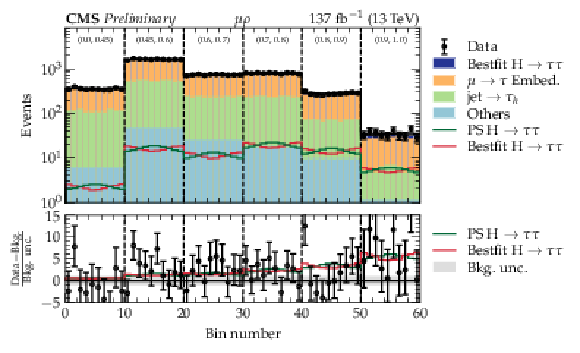
png pdf |
Figure 5-a:
Distributions of ϕCP in the μρ (top) and μπ (bottom) channel in windows of increasing neural net score. The best-fit and pseudoscalar (PS) signal distributions are overlaid. The x axis represents the cyclic bins in ϕCP in the range of (0, 360∘). In the bottom plot the data minus the background template divided by the uncertainty in the background template is displayed, as well as the signal samples divided by the uncertainty in the background template. The uncertainty band consists of the sum of the postfit uncertainties in the background templates. |
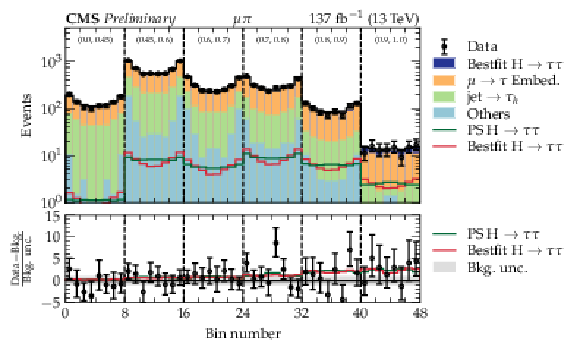
png pdf |
Figure 5-b:
Distributions of ϕCP in the μρ (top) and μπ (bottom) channel in windows of increasing neural net score. The best-fit and pseudoscalar (PS) signal distributions are overlaid. The x axis represents the cyclic bins in ϕCP in the range of (0, 360∘). In the bottom plot the data minus the background template divided by the uncertainty in the background template is displayed, as well as the signal samples divided by the uncertainty in the background template. The uncertainty band consists of the sum of the postfit uncertainties in the background templates. |
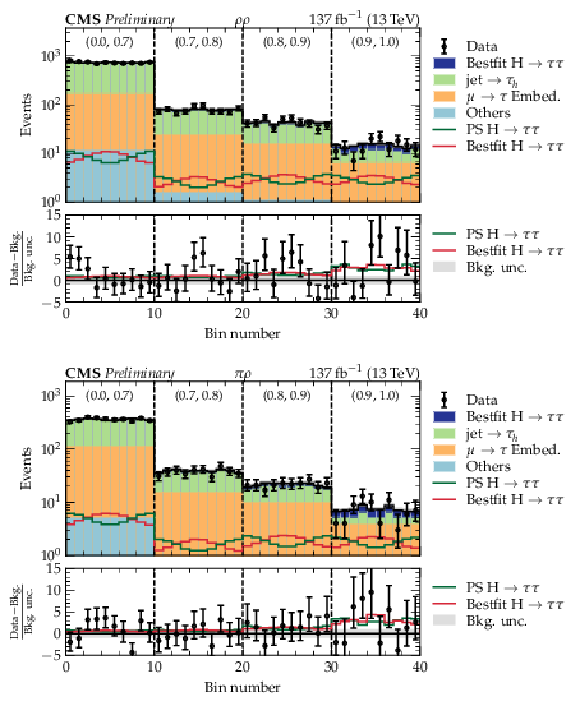
png pdf |
Figure 6:
Distributions of ϕCP in the ρρ (top) and πρ (bottom) channel in windows of increasing BDT score. The best-fit and pseudoscalar (PS) signal distributions are overlaid. The x axis represents the cyclic bins in ϕCP in the range of (0, 360∘). In the bottom plot the data minus the background template divided by the uncertainty in the background template is displayed, as well as the signal samples divided by the uncertainty in the background template. The uncertainty band consists of the sum of the postfit uncertainties in the background templates. |
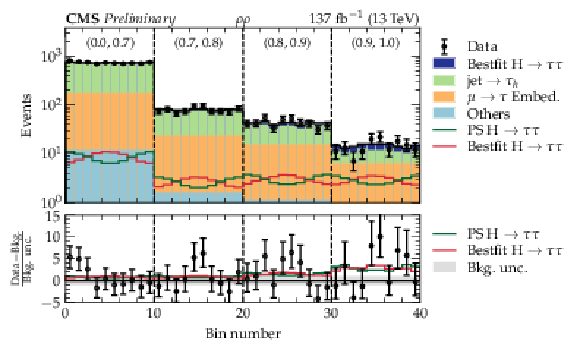
png pdf |
Figure 6-a:
Distributions of ϕCP in the ρρ (top) and πρ (bottom) channel in windows of increasing BDT score. The best-fit and pseudoscalar (PS) signal distributions are overlaid. The x axis represents the cyclic bins in ϕCP in the range of (0, 360∘). In the bottom plot the data minus the background template divided by the uncertainty in the background template is displayed, as well as the signal samples divided by the uncertainty in the background template. The uncertainty band consists of the sum of the postfit uncertainties in the background templates. |

png pdf |
Figure 6-b:
Distributions of ϕCP in the ρρ (top) and πρ (bottom) channel in windows of increasing BDT score. The best-fit and pseudoscalar (PS) signal distributions are overlaid. The x axis represents the cyclic bins in ϕCP in the range of (0, 360∘). In the bottom plot the data minus the background template divided by the uncertainty in the background template is displayed, as well as the signal samples divided by the uncertainty in the background template. The uncertainty band consists of the sum of the postfit uncertainties in the background templates. |
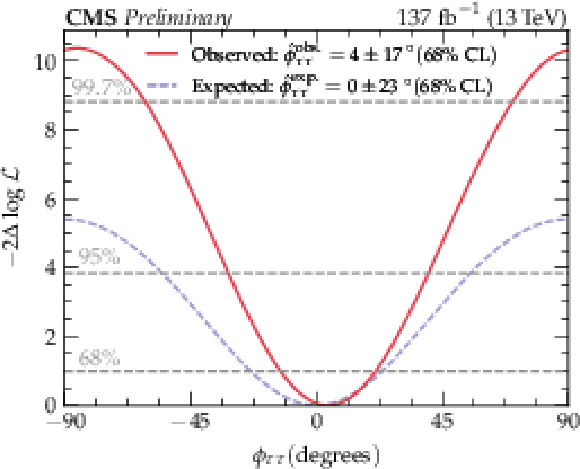
png pdf |
Figure 7:
Negative log-likelihood scan for the combination of the τμτh and τhτh channel. The observed (expected) sensitivity to distinguish between the scalar and pseudo-scalar hypotheses, defined at ϕττ= 0 and ± 90∘, respectively, is 3.2 (2.3) standard deviations. The observed (expected) value for ϕττ is 4 ± 17∘ (0 ± 23∘) at the 68% CL, at the 95% CL the value is ± 36∘ (± 55∘), and at the 99.7% CL we obtain an observed ± 66∘. |

png pdf |
Figure 8:
Two-dimensional scan of the branching fraction modifier with respect to the SM value μττ versus ϕττ. All other Higgs couplings are fixed to the SM expectation values. |

png pdf |
Figure 9:
Two-dimensional scan of the (reduced) CP-even (κ) and CP-odd (˜κ) τ Yukawa couplings. |

png pdf |
Figure 10:
The ϕCP distribution for the three most sensitive channels combined. Events were collected from all years and NN/BDT bins in the three signal categories. The background is subtracted from the data. The events are reweighed via AS/(S+B), in which S and B are the signal and background rates, respectively, and A is a measure for the average asymmetry between the scalar and pseudoscalar distributions. The definition of the value of A per bin is |CPeven−CPodd|/(CPeven+CPodd), and A is normalised to the total number of bins. In this equation CPeven and CPodd are the scalar and pseudoscalar contributions per bin. The scalar distribution is depicted in blue, while the pseudoscalar is displayed in green. In the predictions, the rate parameters are taken from their best-fit values. The grey uncertainty band indicates the uncertainty on the subtracted background component. In combining the channels, a phase-shift of 180∘ was applied to the channel involving a muon since this channel has a phase difference of 180∘ with respect to the two hadronic channels due to a sign-flip in the muon spectral function. |
| Tables | |

png pdf |
Table 1:
Weak decays of τ leptons used in this analysis and their branching fractions B in% [35] are given, rounded to one decimal place. Also, where appropriate, we indicate the known intermediate resonances of all the hadrons listed. The muon is accompanied by two neutrinos, while the hadronic modes involve one neutrino. The third row gives the shorthand notation for the decays used throughout this note. |

png pdf |
Table 2:
Kinematic trigger and offline requirements applied for the τμτh and τhτh channel. The trigger pT requirement is indicated in parentheses (in GeV). The pseudorapidity constraints originate from trigger and reconstruction requirements. |

png pdf |
Table 3:
The different sources of di-τ backgrounds are depicted on the rows and columns. The entries in the table represent the possible di-τ background contribution from different processes and misidentifications and encapsulate the different experimental techniques that are deployed to estimate the background contributions. Processes involving two prompt leptons, i.e. two electrons, muons, or and electron and a muon, are not considered in this analysis. |
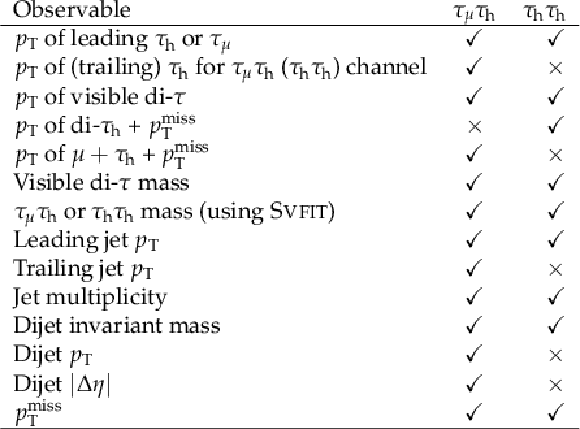
png pdf |
Table 4:
Input variables to the MVA discriminants for the τμτh and τhτh channel. For all variables only the visible decay products of the τ leptons are implied, except for the τμτh and τhτh mass, for which the {Svfit} algorithm is used. |
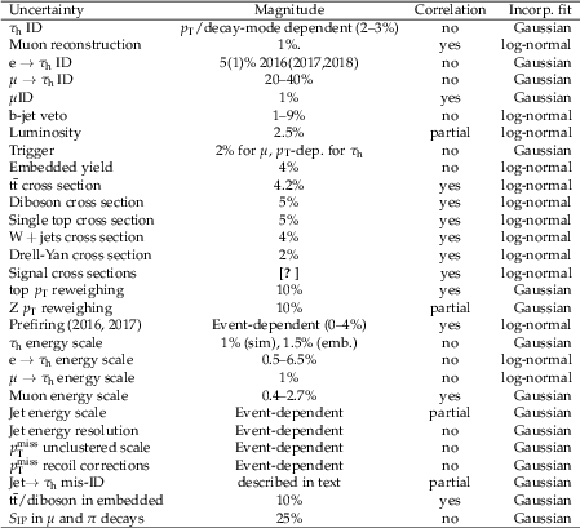
png pdf |
Table 5:
Sources of systematic uncertainties. The third column indicates if the source of uncertainty was treated as being correlated between the years in the fit described in Section 11. The fourth column indicates the probability density for the uncertainty applied in the fit |
| Summary |
| The first measurement of the effective mixing angle ϕττ between a scalar and pseudoscalar Hττ coupling has been presented for a data set of pp collisions at √s= 13 TeV of 137 fb−1. The data were collected with the CMS experiment at the LHC in the period 2016-2018. The fully hadronic channel was included as well as the τμτh channel, in which one τ lepton decayed via a muon and the other to hadrons. Machine learning techniques were applied to separate the signal from background events and distinguish between the hadronic τ decay modes. Dedicated strategies were adopted to reconstruct the angle ϕCP between the τ decay planes for the various τ decay modes, and the reconstruction of the primary vertex was optimised for the measurement. The hypothesis for a pure CP-odd pseudoscalar boson is rejected with 3.2 (2.3) observed (expected) standard deviations. The observed mixing angle is found to be 4 ± 17∘, while the expected value is determined as 0 ± 23∘ at the 68% confidence level. At the 95% confidence level the observed and expected uncertainties are found to be ± 36∘ and ± 55∘, respectively, and the observed sensitivity at the 99.7% CL is ± 66∘. The μρ channel is estimated to be the most sensitive mode, followed by the ρρ and πρ channels. The driving uncertainties in the measurement presented are of statistical nature, implying that the precision of the measurement will increase with the accumulation of more collision data. The measurement is consistent with the standard model expectation, and reduces the allowed parameter space for extensions of the standard model. |
| Additional Figures | |

png pdf |
Additional Figure 1:
The normalised distribution of ϕCP between the τ decay planes in the boson rest frame, for both τ leptons decaying to a muon and an intermediate ρ meson. The distributions are for a decaying scalar (CP even, blue), pseudoscalar (CP odd, green), a maximal mixing angle of 45∘ (CP mix, red), and a Z vector boson (black). A pT cutoff of 19 (16) GeV is applied on the visible leptonic (hadronic) tau decay products. |
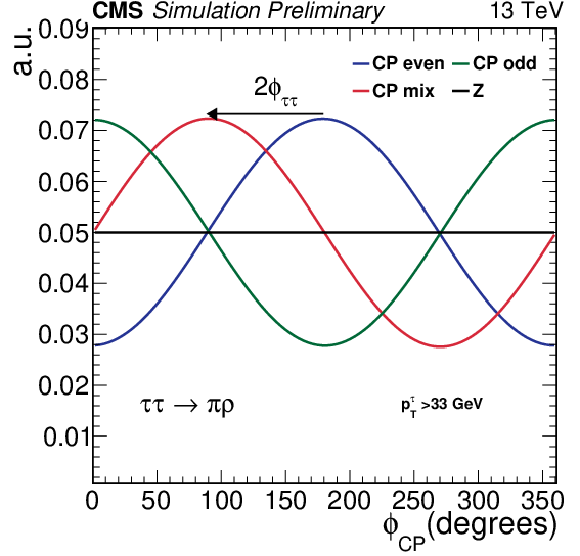
png pdf |
Additional Figure 2:
The normalised distribution of ϕCP between the τ decay planes in the boson rest frame, for both τ leptons decaying to a charged pion and an intermediate ρ meson. The distributions are for a decaying scalar (CP even, blue), pseudoscalar (CP odd, green), a maximal mixing angle of 45∘ (CP mix, red), and a Z vector boson (black). A pT cutoff of 33 GeV is applied on the visible tau decay products. |
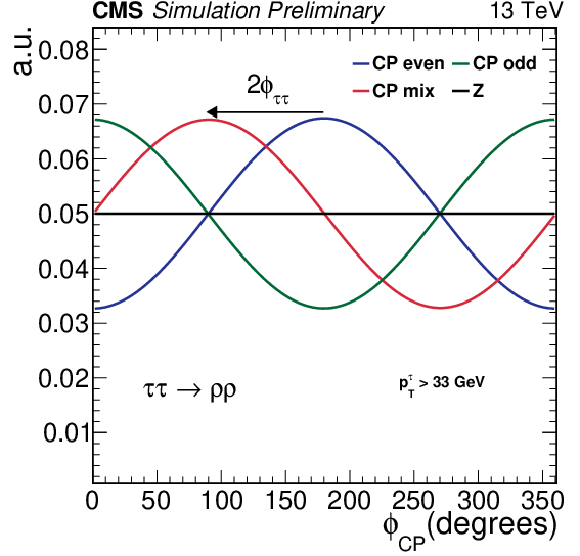
png pdf |
Additional Figure 3:
The normalised distribution of ϕCP between the τ decay planes in the boson rest frame, for both τ leptons decaying to two intermediate ρ mesons. The distributions are for a decaying scalar (CP even, blue), pseudoscalar (CP odd, green), a maximal mixing angle of 45∘ (CP mix, red), and a Z vector boson (black). A pT cutoff of 33 GeV is applied on the visible tau decay products. |
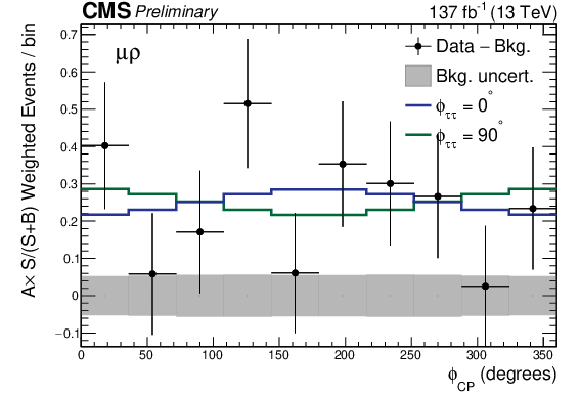
png pdf |
Additional Figure 4:
The ϕCP distribution in the μρ channel. Events were collected from all years and NN/BDT bins. The background is subtracted from the data. The events are reweighed via AS/(S+B), in which S and B are the signal and background rates, respectively, and A is a measure for the average asymmetry between the scalar and pseudoscalar distributions. The definition of the value of A per bin is |CPeven−CPodd|/(CPeven+CPodd), and A is normalised to the total number of bins. In this equation CPeven and CPodd are the scalar and pseudoscalar contributions per bin. The scalar distribution is depicted in blue, while the pseudoscalar is displayed in green. In the predictions the rate parameters are taken from their best-fit values. The grey uncertainty band indicates the uncertainty on the subtracted background component. It should be noted that an overall phase-shift of 180∘ was applied to the channel involving a muon. |

png pdf |
Additional Figure 5:
The ϕCP distribution in the πρ channel. Events were collected from all years and NN/BDT bins. The background is subtracted from the data. The events are reweighed via AS/(S+B), in which S and B are the signal and background rates, respectively, and A is a measure for the average asymmetry between the scalar and pseudoscalar distributions. The definition of the value of A per bin is |CPeven−CPodd|/(CPeven+CPodd), and A is normalised to the total number of bins. In this equation CPeven and CPodd are the scalar and pseudoscalar contributions per bin. The scalar distribution is depicted in blue, while the pseudoscalar is displayed in green. In the predictions the rate parameters are taken from their best-fit values. The grey uncertainty band indicates the uncertainty on the subtracted background component. |
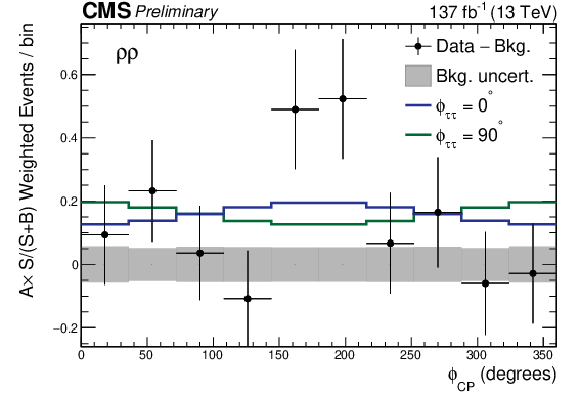
png pdf |
Additional Figure 6:
The ϕCP distribution in the ρρ channel. Events were collected from all years and NN/BDT bins. The background is subtracted from the data. The events are reweighed via AS/(S+B), in which S and B are the signal and background rates, respectively, and A is a measure for the average asymmetry between the scalar and pseudoscalar distributions. The definition of the value of A per bin is |CPeven−CPodd|/(CPeven+CPodd), and A is normalised to the total number of bins. In this equation CPeven and CPodd are the scalar and pseudoscalar contributions per bin. The scalar distribution is depicted in blue, while the pseudoscalar is displayed in green. In the predictions the rate parameters are taken from their best-fit values. The grey uncertainty band indicates the uncertainty on the subtracted background component. |

png pdf |
Additional Figure 7:
The ϕCP distribution for combination of the nine least sensitive τμτh and τhτh channels added together. Events were collected from all years and NN/BDT bins. The background is subtracted from the data. The events are reweighed via AS/(S+B), in which S and B are the signal and background rates, respectively, and A is a measure for the average asymmetry between the scalar and pseudoscalar distributions. The definition of the value of A per bin is |CPeven−CPodd|/(CPeven+CPodd), and A is normalised to the total number of bins. In this equation CPeven and CPodd are the scalar and pseudoscalar contributions per bin. The scalar distribution is depicted in blue, while the pseudoscalar is displayed in green. In the predictions the rate parameters are taken from their best-fit values. The grey uncertainty band indicates the uncertainty on the subtracted background component. In combining the channels, a phase-shift of 180∘ was applied to the channels involving a muon since this channel has a phase difference of 180∘ with respect to the two hadronic channels due to a sign-flip in the muon spectral function. |
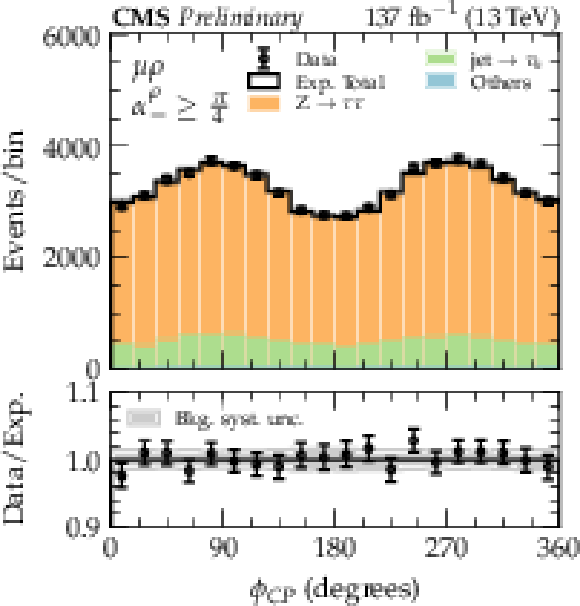
png pdf |
Additional Figure 8:
Distributions of ϕCP in the μρ channel for an event sample dominated by Drell-Yan events. Events were selected for which αρ−≥π/4. The Drell-Yan background template is extracted from simulation, while the jet-fake background is obtained from the fake-factor method. The remaining backgrounds are summarised in the template named Other. In the lower plot the ratio between data and the prediction is displayed together with the systematic uncertainty band. |
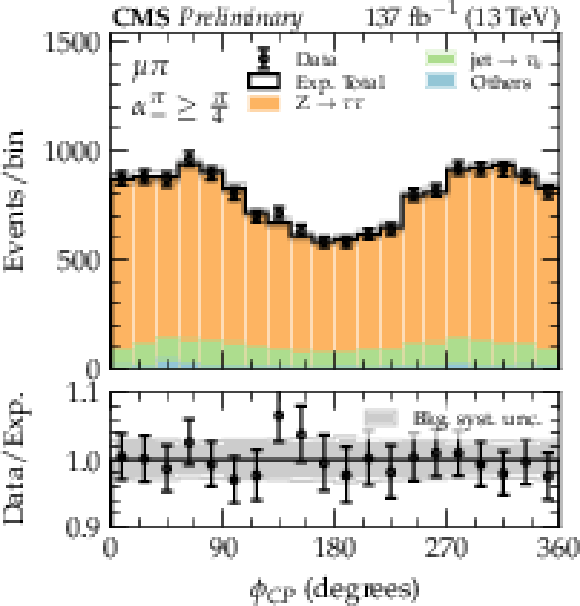
png pdf |
Additional Figure 9:
Distributions of ϕCP in the μπ channel for an event sample dominated by Drell-Yan events. Events were selected for which απ−≥π/4. The Drell-Yan background template is extracted from simulation, while the jet-fake background is obtained from the fake-factor method. The remaining backgrounds are summarised in the template named Other. In the lower plot the ratio between data and the prediction is displayed together with the systematic uncertainty band. |
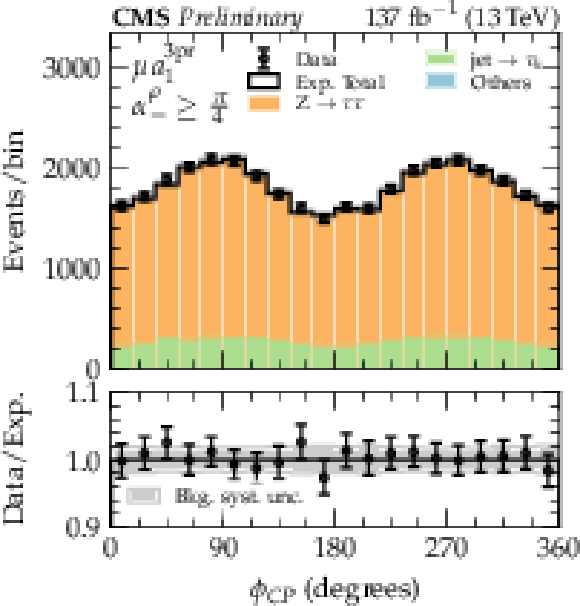
png pdf |
Additional Figure 10:
Distributions of ϕCP in the μa3pr1 channel for an event sample dominated by Drell-Yan events. Events were selected for which αρ−≥π/4 for the intermediate ρ. The Drell-Yan background template is extracted from simulation, while the jet-fake background is obtained from the fake-factor method. The remaining backgrounds are summarised in the template named Other. In the lower plot the ratio between data and the prediction is displayed together with the systematic uncertainty band. |

png pdf |
Additional Figure 11:
Distributions of ϕCP in the μa1pr1 channel for an event sample dominated by Drell-Yan events. Events were selected for which α−, calculated for the intermediate a1pr1, was ≥π/4. The Drell-Yan background template is extracted from simulation, while the jet-fake background is obtained from the fake-factor method. The remaining backgrounds are summarised in the template named Other. In the lower plot the ratio between data and the prediction is displayed together with the systematic uncertainty band. |
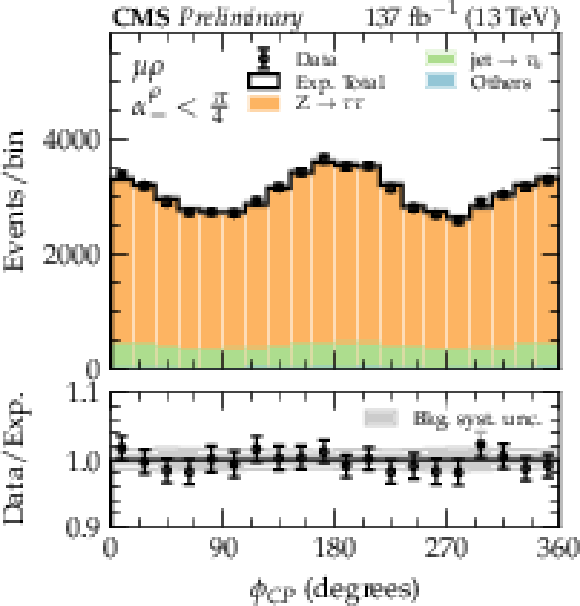
png pdf |
Additional Figure 12:
Distributions of ϕCP in the μρ channel for an event sample dominated by Drell-Yan events. Events were selected for which αρ−<π/4. The Drell-Yan background template is extracted from simulation, while the jet-fake background is obtained from the fake-factor method. The remaining backgrounds are summarised in the template named Other. In the lower plot the ratio between data and the prediction is displayed together with the systematic uncertainty band. |

png pdf |
Additional Figure 13:
Distributions of ϕCP in the μπ channel for an event sample dominated by Drell-Yan events. Events were selected for which απ−<π/4. The Drell-Yan background template is extracted from simulation, while the jet-fake background is obtained from the fake-factor method. The remaining backgrounds are summarised in the template named Other. In the lower plot the ratio between data and the prediction is displayed together with the systematic uncertainty band. |
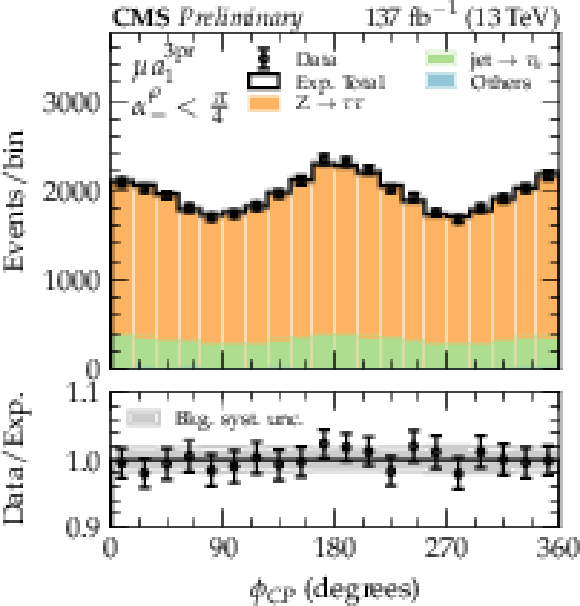
png pdf |
Additional Figure 14:
Distributions of ϕCP in the μa3pr1 channel for an event sample dominated by Drell-Yan events. Events were selected for which αρ−<π/4 for the intermediate ρ. The Drell-Yan background template is extracted from simulation, while the jet-fake background is obtained from the fake-factor method. The remaining backgrounds are summarised in the template named Other. In the lower plot the ratio between data and the prediction is displayed together with the systematic uncertainty band. |
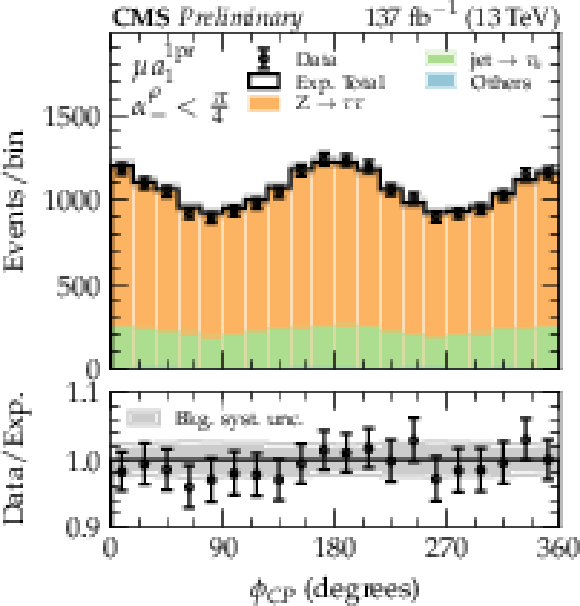
png pdf |
Additional Figure 15:
Distributions of ϕCP in the μa1pr1 channel for an event sample dominated by Drell-Yan events. Events were selected for which α−, calculated for the intermediate a1pr1, was <π/4. The Drell-Yan background template is extracted from simulation, while the jet-fake background is obtained from the fake-factor method. The remaining backgrounds are summarised in the template named Other. In the lower plot the ratio between data and the prediction is displayed together with the systematic uncertainty band. |
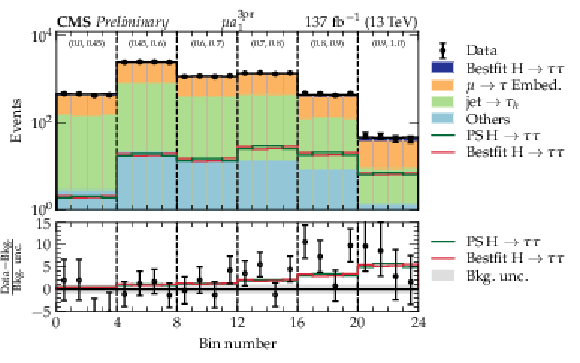
png pdf |
Additional Figure 16:
Distributions of ϕCP in the μa3pr1 channel in windows of increasing neural net score. The best-fit and pseudoscalar (PS) signal distributions are overlaid. The x axis represents the cyclic bins in ϕCP in the range of (0, 360∘). In the bottom plot the data minus the background template divided by the uncertainty in the background template is displayed, as well as the signal samples divided by the uncertainty in the background template. The uncertainty band consists of the sum of the postfit uncertainties in the background templates. |

png pdf |
Additional Figure 17:
Distributions of ϕCP in the μa1pr1 channel in windows of increasing neural net score. The best-fit and pseudoscalar (PS) signal distributions are overlaid. The x axis represents the cyclic bins in ϕCP in the range of (0, 360∘). In the bottom plot the data minus the background template divided by the uncertainty in the background template is displayed, as well as the signal samples divided by the uncertainty in the background template. The uncertainty band consists of the sum of the postfit uncertainties in the background templates. |
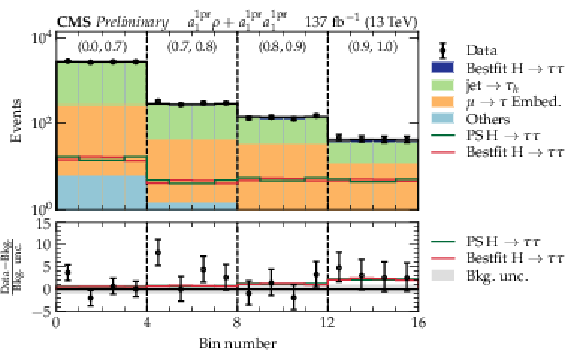
png pdf |
Additional Figure 18:
Distributions of ϕCP in the a1pr1ρ+a1pr1a1pr1 channel in windows of increasing boosted decision tree score. The best-fit and pseudoscalar (PS) signal distributions are overlaid. The x axis represents the cyclic bins in ϕCP in the range of (0, 360∘). In the bottom plot the data minus the background template divided by the uncertainty in the background template is displayed, as well as the signal samples divided by the uncertainty in the background template. The uncertainty band consists of the sum of the postfit uncertainties in the background templates. |

png pdf |
Additional Figure 19:
Distributions of ϕCP in the a3pr1a1pr1 channel in windows of increasing boosted decision tree score. The best-fit and pseudoscalar (PS) signal distributions are overlaid. The x axis represents the cyclic bins in ϕCP in the range of (0, 360∘). In the bottom plot the data minus the background template divided by the uncertainty in the background template is displayed, as well as the signal samples divided by the uncertainty in the background template. The uncertainty band consists of the sum of the postfit uncertainties in the background templates. |
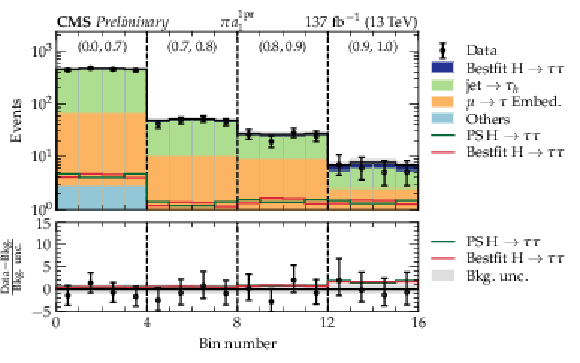
png pdf |
Additional Figure 20:
Distributions of ϕCP in the πa1pr1 channel in windows of increasing boosted decision tree score. The best-fit and pseudoscalar (PS) signal distributions are overlaid. The x axis represents the cyclic bins in ϕCP in the range of (0, 360∘). In the bottom plot the data minus the background template divided by the uncertainty in the background template is displayed, as well as the signal samples divided by the uncertainty in the background template. The uncertainty band consists of the sum of the postfit uncertainties in the background templates. |
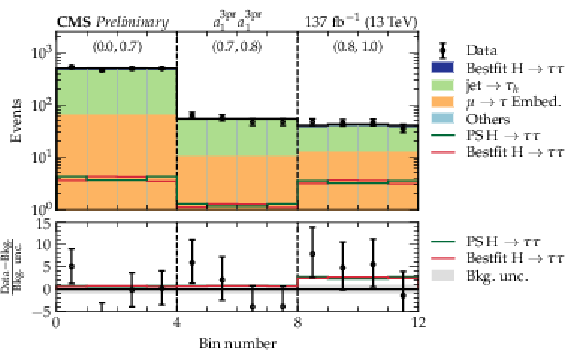
png pdf |
Additional Figure 21:
Distributions of ϕCP in the a3pr1a3pr1 channel in windows of increasing boosted decision tree score. The best-fit and pseudoscalar (PS) signal distributions are overlaid. The x axis represents the cyclic bins in ϕCP in the range of (0, 360∘). In the bottom plot the data minus the background template divided by the uncertainty in the background template is displayed, as well as the signal samples divided by the uncertainty in the background template. The uncertainty band consists of the sum of the postfit uncertainties in the background templates. |
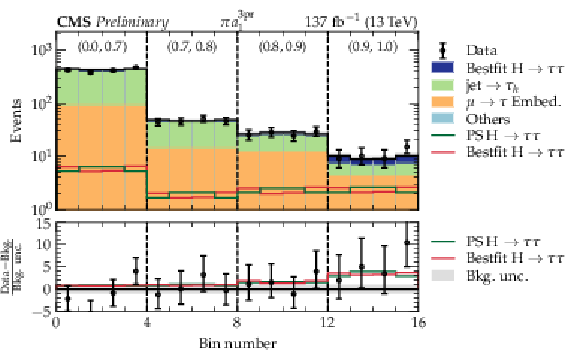
png pdf |
Additional Figure 22:
Distributions of ϕCP in the πa3pr1 channel in windows of increasing boosted decision tree score. The best-fit and pseudoscalar (PS) signal distributions are overlaid. The x axis represents the cyclic bins in ϕCP in the range of (0, 360∘). In the bottom plot the data minus the background template divided by the uncertainty in the background template is displayed, as well as the signal samples divided by the uncertainty in the background template. The uncertainty band consists of the sum of the postfit uncertainties in the background templates. |

png pdf |
Additional Figure 23:
Distributions of ϕCP in the a3pr1ρ channel in windows of increasing neural net score. The best-fit and pseudoscalar (PS) signal distributions are overlaid. The x axis represents the cyclic bins in ϕCP in the range of (0, 360∘). In the bottom plot the data minus the background template divided by the uncertainty in the background template is displayed, as well as the signal samples divided by the uncertainty in the background template. The uncertainty band consists of the sum of the postfit uncertainties in the background templates. |
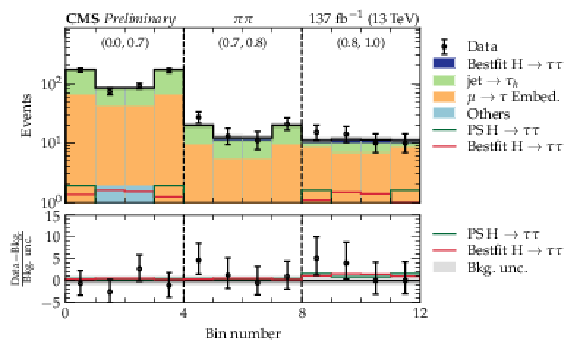
png pdf |
Additional Figure 24:
Distributions of ϕCP in the ππ channel in windows of increasing boosted decision tree score. The best-fit and pseudoscalar (PS) signal distributions are overlaid. The x axis represents the cyclic bins in ϕCP in the range of (0, 360∘). In the bottom plot the data minus the background template divided by the uncertainty in the background template is displayed, as well as the signal samples divided by the uncertainty in the background template. The uncertainty band consists of the sum of the postfit uncertainties in the background templates. |
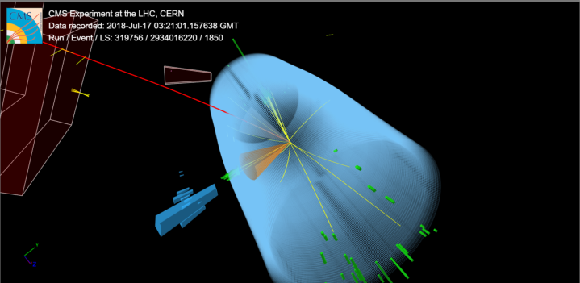
png pdf |
Additional Figure 25-a:
A candidate event featuring a Higgs decaying into two τ leptons is depicted. The τ leptons decay into a muon (in red) and an a3pr1 that decays in three charged pions (indicated by the orange cone and the calorimeter cells). |
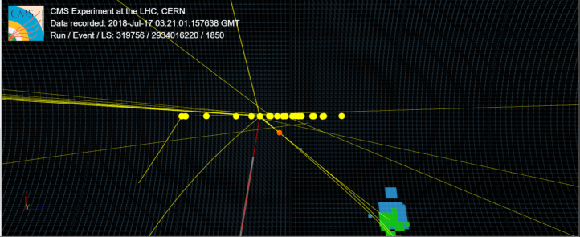
png pdf |
Additional Figure 25-b:
A zoomed view on the same event is featured revealing the displaced secondary vertex of which the tracks of the three charged pions candidate are emerging. The pileup vertices are also indicated. |
| Additional Tables | |
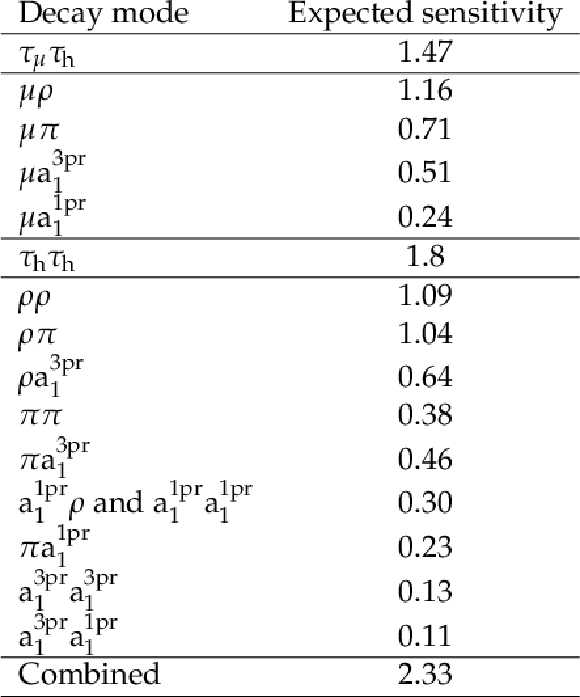
png pdf |
Additional Table 1:
The obtained expected sensitivities in standard deviations to distinguish between a CP-even and odd Hττ coupling. Results are displayed for the individual decay modes, the combined τμτh and τhτh channel, and the overall combination. |

png pdf |
Additional Table 2:
The primary vertex resolution in cm. The resolution is stated for the nominal primary vertex as reconstructed by default reconstruction algorithms utilised by the CMS experiment, as well as the refitted beamspot-corrected primary vertex as used throughout this analysis. |
| References | ||||
| 1 | F. Englert and R. Brout | Broken symmetry and the mass of gauge vector mesons | PRL 13 (1964) 321 | |
| 2 | P. W. Higgs | Broken symmetries and the masses of gauge bosons | PRL 13 (1964) 508 | |
| 3 | G. S. Guralnik, C. R. Hagen, and T. W. B. Kibble | Global conservation laws and massless particles | PRL 13 (1964) 585 | |
| 4 | ATLAS Collaboration | Observation of a new particle in the search for the Standard Model Higgs boson with the ATLAS detector at the LHC | Physics Letters B 716 (2012), no. 1, 1 | 1207.7214 |
| 5 | CMS Collaboration | Observation of a new boson at a mass of 125 GeV with the CMS experiment at the LHC | Physics Letters B 716 (2012), no. 1, 30 | CMS-HIG-12-028 1207.7235 |
| 6 | ATLAS, CMS Collaboration | Measurements of the Higgs boson production and decay rates and constraints on its couplings from a combined ATLAS and CMS analysis of the LHC pp collision data at √s= 7 and 8 TeV | JHEP 08 (2016) 045 | 1606.02266 |
| 7 | CMS Collaboration | Observation of the Higgs boson decay to a pair of τ leptons with the CMS detector | Physics Letters B 779 (2018) 283 | CMS-HIG-16-043 1708.00373 |
| 8 | ATLAS Collaboration | Cross-section measurements of the Higgs boson decaying into a pair of τ-leptons in proton-proton collisions at a centre-of-mass energy of 13~TeV with the ATLAS detector | Physical Review D 99 (2019), no. 7 | 1811.08856 |
| 9 | CMS Collaboration | On the mass and spin-parity of the Higgs boson candidate via its decays to Z boson pairs | PRL 110 (2013) 081803 | CMS-HIG-12-041 1212.6639 |
| 10 | CMS Collaboration | Measurement of the properties of a Higgs boson in the four-lepton final state | PRD 89 (2014) 092007 | CMS-HIG-13-002 1312.5353 |
| 11 | CMS Collaboration | Constraints on the spin-parity and anomalous HVV couplings of the Higgs boson in proton collisions at 7 and 8 TeV | PRD 92 (2015) 012004 | CMS-HIG-14-018 1411.3441 |
| 12 | CMS Collaboration | Limits on the Higgs boson lifetime and width from its decay to four charged leptons | PRD 92 (2015) 072010 | CMS-HIG-14-036 1507.06656 |
| 13 | CMS Collaboration | Combined search for anomalous pseudoscalar HVV couplings in VH(H →bˉb) production and H → VV decay | PLB 759 (2016) 672 | CMS-HIG-14-035 1602.04305 |
| 14 | CMS Collaboration | Constraints on anomalous Higgs boson couplings using production and decay information in the four-lepton final state | PLB 775 (2017) 1 | CMS-HIG-17-011 1707.00541 |
| 15 | CMS Collaboration | Constraints on anomalous HVV couplings from the production of Higgs bosons decaying to τ lepton pairs | Physical Review D 100 (2019), no. 11 | CMS-HIG-17-034 1903.06973 |
| 16 | ATLAS Collaboration | Evidence for the spin-0 nature of the Higgs boson using ATLAS data | PLB 726 (2013) 120 | 1307.1432 |
| 17 | ATLAS Collaboration | Study of the spin and parity of the Higgs boson in diboson decays with the ATLAS detector | EPJC 75 (2015) 476 | 1506.05669 |
| 18 | ATLAS Collaboration | Test of CP Invariance in vector-boson fusion production of the Higgs boson using the Optimal Observable method in the ditau decay channel with the ATLAS detector | EPJC 76 (2016) 658 | 1602.04516 |
| 19 | ATLAS Collaboration | Measurement of inclusive and differential cross sections in the H→ZZ∗→4ℓ decay channel in pp collisions at √s= 13 TeV with the ATLAS detector | JHEP 10 (2017) 132 | 1708.02810 |
| 20 | ATLAS Collaboration | Measurement of the Higgs boson coupling properties in the H→ZZ∗→4ℓ decay channel at √s= 13 TeV with the ATLAS detector | JHEP 03 (2018) 095 | 1712.02304 |
| 21 | ATLAS Collaboration | Measurements of Higgs boson properties in the diphoton decay channel with 36 fb−1 of pp collision data at √s= 13 TeV with the ATLAS detector | PRD 98 (2018) 052005 | 1802.04146 |
| 22 | C. Zhang and S. Willenbrock | Effective-field-theory approach to top-quark production and decay | Physical Review D 83 (2011), no. 3 | 1008.3869 |
| 23 | R. Harnik et al. | Measuring CP violation in h→τ+τ− at colliders | Physical Review D 88 (2013), no. 7 | 1308.1094 |
| 24 | T. Ghosh, R. Godbole, and X. Tata | Determining the spacetime structure of bottom-quark couplings to spin-zero particles | Physical Review D 100 (2019), no. 1 | 1904.09895 |
| 25 | A. V. Gritsan, R. Rontsch, M. Schulze, and M. Xiao | Constraining anomalous Higgs boson couplings to the heavy-flavor fermions using matrix element techniques | Physical Review D 94 (2016), no. 5 | 1606.03107 |
| 26 | CMS Collaboration | Measurements of tˉtH production and the CP structure of the Yukawa interaction between the Higgs boson and top quark in the diphoton decay channel | Submitted to PRL | CMS-HIG-19-013 2003.10866 |
| 27 | ATLAS Collaboration | Study of the CP properties of the interaction of the Higgs boson with top quarks using top quark associated production of the Higgs boson and its decay into two photons with the ATLAS detector at the LHC | Submitted to PRLett | 2004.04545 |
| 28 | D. Fontes, J. C. Romão, R. Santos, and J. P. Silva | Large pseudoscalar Yukawa couplings in the complex 2HDM | JHEP 06 (2015) 060 | 1502.01720 |
| 29 | S. King, M. Muhlleitner, R. Nevzorov, and K. Walz | Exploring the CP-violating NMSSM: EDM constraints and phenomenology | Nuclear Physics B 901 (2015) 526 | 1508.03255 |
| 30 | S. Berge, W. Bernreuther, and S. Kirchner | Determination of the Higgs CP-mixing angle in the tau decay channels at the LHC including the Drell--Yan background | The European Physical Journal C 74 (2014), no. 11 | 1408.0798 |
| 31 | ATLAS Collaboration | Probing the CP nature of the Higgs boson coupling to τ leptons at HL-LHC | ATL-PHYS-PUB-2019-008 | |
| 32 | M. Kramer, J. Kuhn, M. L. Stong, and P. M. Zerwas | Prospects of measuring the parity of Higgs particles | Zeitschrift f\"ur Physik C Particles and Fields 64 (1994), no. 1, 21 | hep-ph/9404280 |
| 33 | V. Barger et al. | Higgs bosons: Intermediate mass range at e+e- colliders | Physical Review D 49 (1994), no. 1, 79 | hep-ph/9306270 |
| 34 | J. R. Dell'Aquila and C. A. Nelson | Distinguishing a spin-0 technipion and an elementary Higgs boson: V1V2 modes with decays into \text{I}^-_a \boldsymbol{l}_b and/or \text{q}^-_a \boldsymbol{q}_b | PRD 33 (1986) 93 | |
| 35 | K. Olive | Review of particle physics | Chinese Physics C 40 (2016), no. 10, 100001 | |
| 36 | S. Berge, W. Bernreuther, B. Niepelt, and H. Spiesberger | How to pin down the CP quantum numbers of a Higgs boson in its \tau decays at the LHC | Physical Review D 84 (2011), no. 11 | 1108.0670 |
| 37 | K. Desch, A. Imhof, Z. Was, and M. Worek | Probing the CP nature of the Higgs boson at linear colliders with \tau spin correlations; the case of mixed scalar-pseudoscalar couplings | Physics Letters B 579 (2004), no. 1-2, 157 | 0307.331 |
| 38 | G. Bower, T. Pierzchala, Z. Was, and M. Worek | Measuring the Higgs boson's parity using \tau\rightarrow\rho\nu | Physics Letters B 543 (2002), no. 3-4, 227 | hep-ph/0204292 |
| 39 | CMS Collaboration | The CMS trigger system | JINST 12 (2017) P01020 | CMS-TRG-12-001 1609.02366 |
| 40 | CMS Collaboration | The CMS experiment at the CERN LHC | JINST 3 (2008) S08004 | CMS-00-001 |
| 41 | P. Nason | A new method for combining NLO QCD with shower Monte Carlo algorithms | JHEP 11 (2004) 040 | hep-ph/0409146 |
| 42 | S. Frixione, P. Nason, and C. Oleari | Matching NLO QCD computations with parton shower simulations: the POWHEG method | JHEP 11 (2007) 070 | 0709.2092 |
| 43 | S. Alioli, P. Nason, C. Oleari, and E. Re | A general framework for implementing NLO calculations in shower Monte Carlo programs: the POWHEG BOX | JHEP 06 (2010) 043 | 1002.2581 |
| 44 | S. Alioli et al. | Jet pair production in POWHEG | JHEP 04 (2011) 081 | 1012.3380 |
| 45 | S. Alioli, P. Nason, C. Oleari, and E. Re | NLO Higgs boson production via gluon fusion matched with shower in POWHEG | JHEP 04 (2009) 002 | 0812.0578 |
| 46 | D. de Florian, G. Ferrera, M. Grazzini, and D. Tommasini | Higgs boson production at the LHC: transverse momentum resummation effects in the \text{H}\rightarrow\gamma\gamma , \text{H}\rightarrow\text{WW}\rightarrow\text{l}\nu\text{l}\nu and \text{H}\rightarrow\text{ZZ}\rightarrow{4\text{l}} decay modes | Journal of High Energy Physics 2012 (2012), no. 6 | 1203.6321 |
| 47 | M. Grazzini and H. Sargsyan | Heavy-quark mass effects in Higgs boson production at the LHC | Journal of High Energy Physics 2013 (2013), no. 9 | 1306.4581 |
| 48 | T. Sjostrand, S. Mrenna, and P. Z. Skands | A Brief Introduction to PYTHIA 8.1 | CPC 178 (2008) 852 | 0710.3820 |
| 49 | T. Sjostrand et al. | An introduction to PYTHIA 8.2 | CPC 191 (2015) 159 | 1410.3012 |
| 50 | T. Przedzinski, E. Richter-Was, and Z. Was | Documentation of TauSpinner algorithms: program for simulating spin effects in \tau -lepton production at LHC | EPJC 79 (2019), no. 2, 91 | 1802.05459 |
| 51 | J. Alwall et al. | The automated computation of tree-level and next-to-leading order differential cross sections, and their matching to parton shower simulations | JHEP 07 (2014) 079 | 1405.0301 |
| 52 | J. Alwall et al. | Comparative study of various algorithms for the merging of parton showers and matrix elements in hadronic collisions | EPJC 53 (2008) 473 | 0706.2569 |
| 53 | CMS Collaboration | Event generator tunes obtained from underlying event and multiparton scattering measurements | EPJC 76 (2016) 155 | CMS-GEN-14-001 1512.00815 |
| 54 | GEANT4 Collaboration | GEANT4--a simulation toolkit | NIMA 506 (2003) 250 | |
| 55 | CMS Collaboration | Particle-flow reconstruction and global event description with the CMS detector | JINST 12 (2017), no. 10, P10003 | CMS-PRF-14-001 1706.04965 |
| 56 | CMS Collaboration | Performance of CMS muon reconstruction in pp collision events at \sqrt{s}= 7 TeV | JINST 7 (2012) P10002 | CMS-MUO-10-004 1206.4071 |
| 57 | CMS Collaboration | Performance of electron reconstruction and selection with the CMS detector in proton-proton collisions at \sqrt{s} = 8 TeV | JINST 10 (2015) P06005 | CMS-EGM-13-001 1502.02701 |
| 58 | M. Cacciari, G. P. Salam, and G. Soyez | The anti- k_t jet clustering algorithm | JHEP 04 (2008) 063 | 0802.1189 |
| 59 | CMS Collaboration | Jet algorithms performance in 13 TeV data | CMS-PAS-JME-16-003 | CMS-PAS-JME-16-003 |
| 60 | CMS Collaboration | Identification of heavy-flavour jets with the CMS detector in pp collisions at 13 TeV | Journal of Instrumentation 13 (2018), no. 05, P05011 | CMS-BTV-16-002 1712.07158 |
| 61 | CMS Collaboration | Performance of missing transverse momentum in pp collisions at \sqrt{s}= 13 TeV using the CMS detector | CMS-PAS-JME-17-001 | CMS-PAS-JME-17-001 |
| 62 | CMS Collaboration | Performance of reconstruction and identification of \tau leptons decaying to hadrons and \nu_{\tau} in pp collisions at \sqrt{s}= 13 TeV | Journal of Instrumentation 13 (2018), no. 10, P10005 | CMS-TAU-16-003 1809.02816 |
| 63 | CMS Collaboration | Performance of the DeepTau algorithm for the discrimination of taus against jets, electron, and muons | CDS | |
| 64 | T. Chen and C. Guestrin | Xgboost: A scalable tree boosting system | in Proceedings of the 22nd ACM SIGKDD International Conference on Knowledge Discovery and Data Mining, KDD '16, p. 785 Association for Computing Machinery, New York, NY, USA | 1603.02754 |
| 65 | CMS Collaboration | Description and performance of track and primary-vertex reconstruction with the CMS tracker | JINST 9 (2014) P10009 | CMS-TRK-11-001 1405.6569 |
| 66 | K. Rose | Deterministic annealing for clustering, compression, classification, regression, and related optimization problems | Proceedings of the IEEE 86 (1998), no. 11 | |
| 67 | W. Waltenberger, R. Fruhwirth, and P. Vanlaer | Adaptive vertex fitting | Journal of Physics G: Nuclear and Particle Physics 34 (2007), no. 12, N343 | |
| 68 | CMS Collaboration | An embedding technique to determine \tau\tau backgrounds in proton-proton collision data | Journal of Instrumentation 14 (2019), no. 06, P06032 | CMS-TAU-18-001 1903.01216 |
| 69 | CMS Collaboration | Measurement of the \mathrm{Z}\gamma^{*} \to \tau\tau cross section in pp collisions at \sqrt{s} = 13 TeV and validation of \tau lepton analysis techniques | EPJC 78 (2018), no. 9, 708 | CMS-HIG-15-007 1801.03535 |
| 70 | CMS Collaboration | Measurements of inclusive W and Z cross sections in pp collisions at \sqrt {s} = 7 TeV | Journal of High Energy Physics 2011 (2011), no. 1 | CMS-EWK-10-002 1012.2466 |
| 71 | CMS Collaboration | Determination of jet energy calibration and transverse momentum resolution in CMS | Journal of Instrumentation 6 (2011), no. 11, 11002 | CMS-JME-10-011 1107.4277 |
| 72 | CMS Collaboration | Measurement of the differential cross section for top quark pair production in pp collisions at \sqrt{s} = 8 TeV | The European Physical Journal C 75 (2015), no. 11 | CMS-TOP-12-028 1505.04480 |
| 73 | CMS Collaboration | Measurement of Higgs boson production and decay to the \tau\tau final state | CMS-PAS-HIG-18-032 | CMS-PAS-HIG-18-032 |
| 74 | S. Berge, W. Bernreuther, and S. Kirchner | Prospects of constraining the Higgs boson's CP nature in the tau decay channel at the LHC | Physical Review D 92 (2015), no. 9 | 1510.03850 |
| 75 | CMS Collaboration | CMS Luminosity Measurements for the 2016 Data Taking Period | CMS-PAS-LUM-17-001 | CMS-PAS-LUM-17-001 |
| 76 | CMS Collaboration | CMS luminosity measurement for the 2017 data-taking period at \sqrt{s} = 13 TeV | CMS-PAS-LUM-17-004 | CMS-PAS-LUM-17-004 |
| 77 | CMS Collaboration | CMS luminosity measurement for the 2018 data-taking period at \sqrt{s} = 13 TeV | CMS-PAS-LUM-18-002 | CMS-PAS-LUM-18-002 |
| 78 | Y. Li and F. Petriello | Combining QCD and electroweak corrections to dilepton production in the framework of the FEWZ simulation code | Physical Review D 86 (2012), no. 9 | 1208.5967 |
| 79 | M. Czakon and A. Mitov | Top++: A program for the calculation of the top-pair cross-section at hadron colliders | Computer Physics Communications 185 (2014), no. 11 | 1112.5675 |
| 80 | CMS Collaboration | Measurement of the WZ production cross section in pp collisions at \sqrt{s}= 13 TeV | Physics Letters B 766 (2017) 268 | CMS-SMP-16-002 1607.06943 |
| 81 | CMS Collaboration | Cross section measurement of t-channel single top quark production in pp collisions at \sqrt{s}= 13 TeV | Physics Letters B 772 (2017) 752 | CMS-TOP-16-003 1610.00678 |
| 82 | LHC Higgs Cross Section Working Group | Handbook of LHC Higgs cross sections: 4. deciphering the nature of the Higgs sector | CERN (2016) | 1610.07922 |
| 83 | R. Barlow and C. Beeston | Fitting using finite monte carlo samples | Computer Physics Communications 77 (1993) 219 | |
| 84 | J. S. Conway | Incorporating Nuisance Parameters in Likelihoods for Multisource Spectra | To be published in a CERN Yellow Report | 1103.0354 |
| 85 | The ATLAS Collaboration, The CMS Collaboration, The LHC Higgs Combination Group | Procedure for the LHC Higgs boson search combination in Summer 2011 | CMS-NOTE-2011-005 | |
| 86 | CMS Collaboration | Precise determination of the mass of the Higgs boson and tests of compatibility of its couplings with the standard model predictions using proton collisions at 7 and 8 TeV | EPJC 75 (2015) 212 | CMS-HIG-14-009 1412.8662 |

|
Compact Muon Solenoid LHC, CERN |

|

|

|

|

|

|